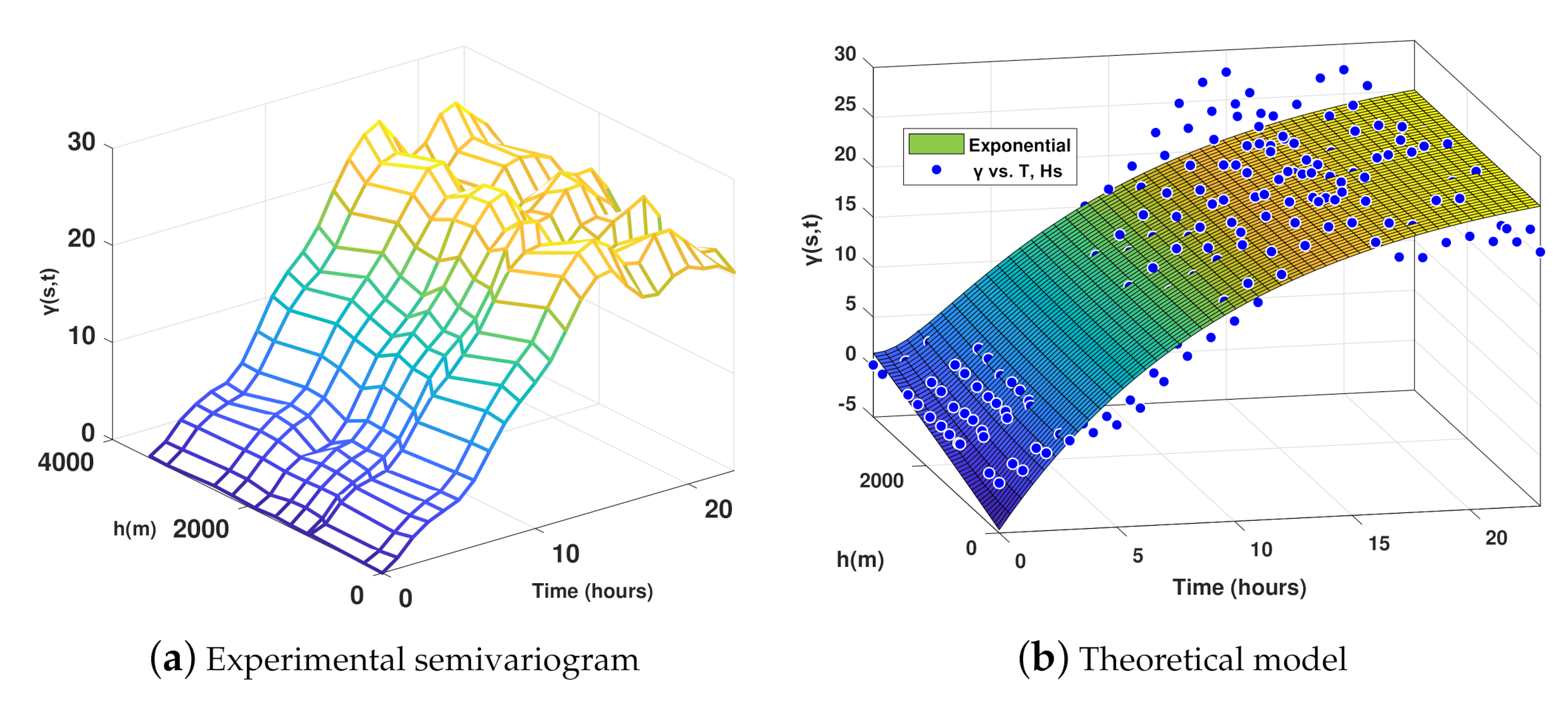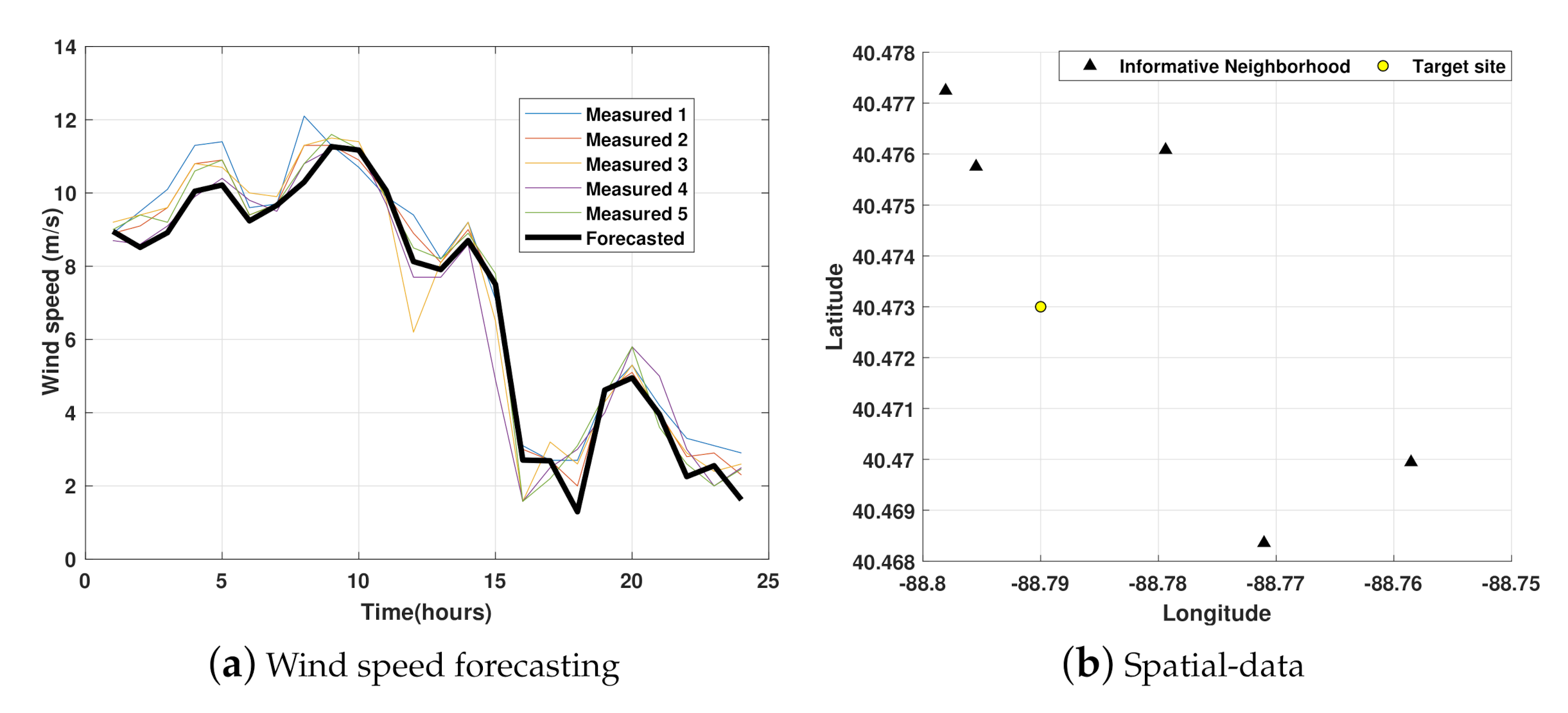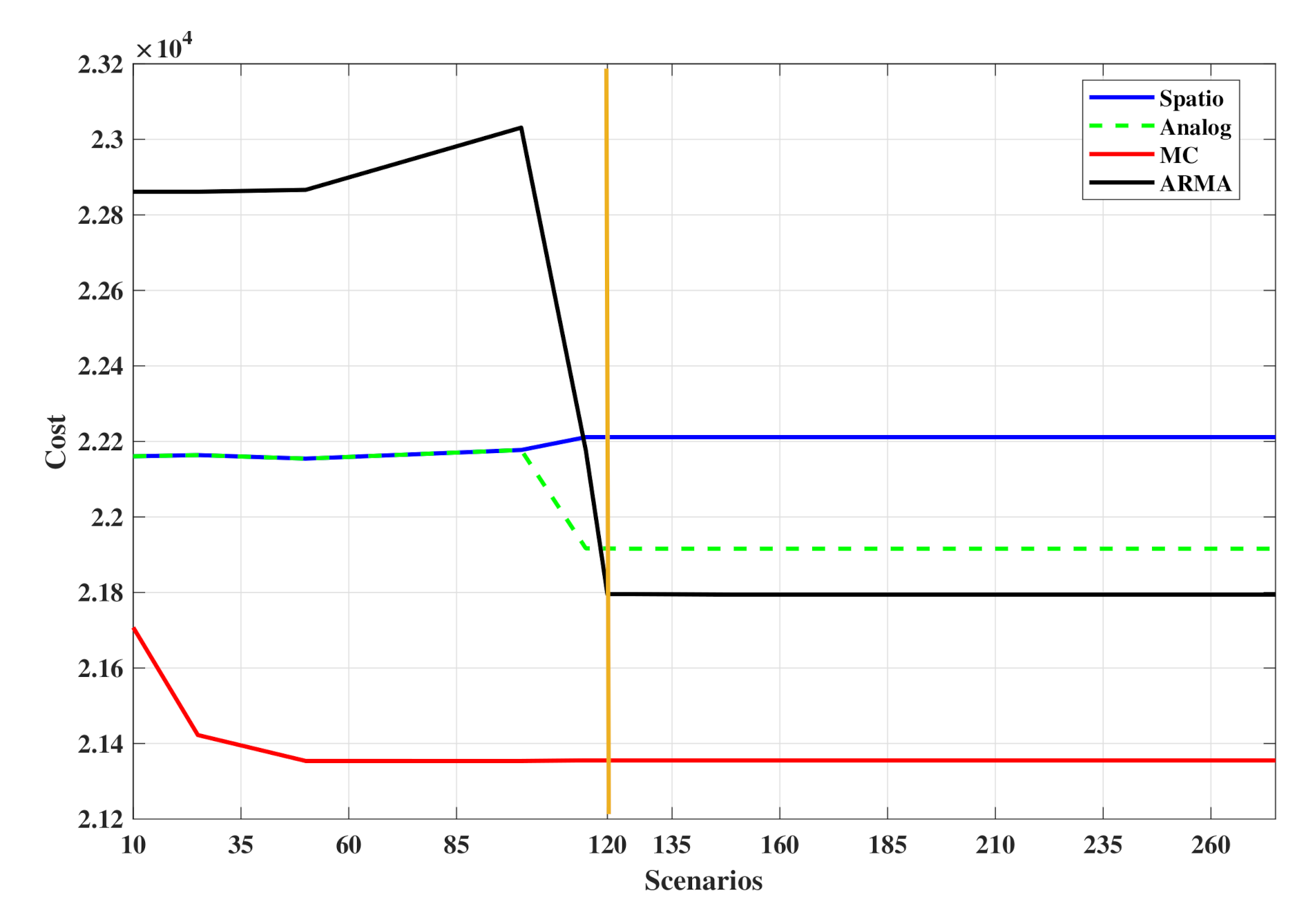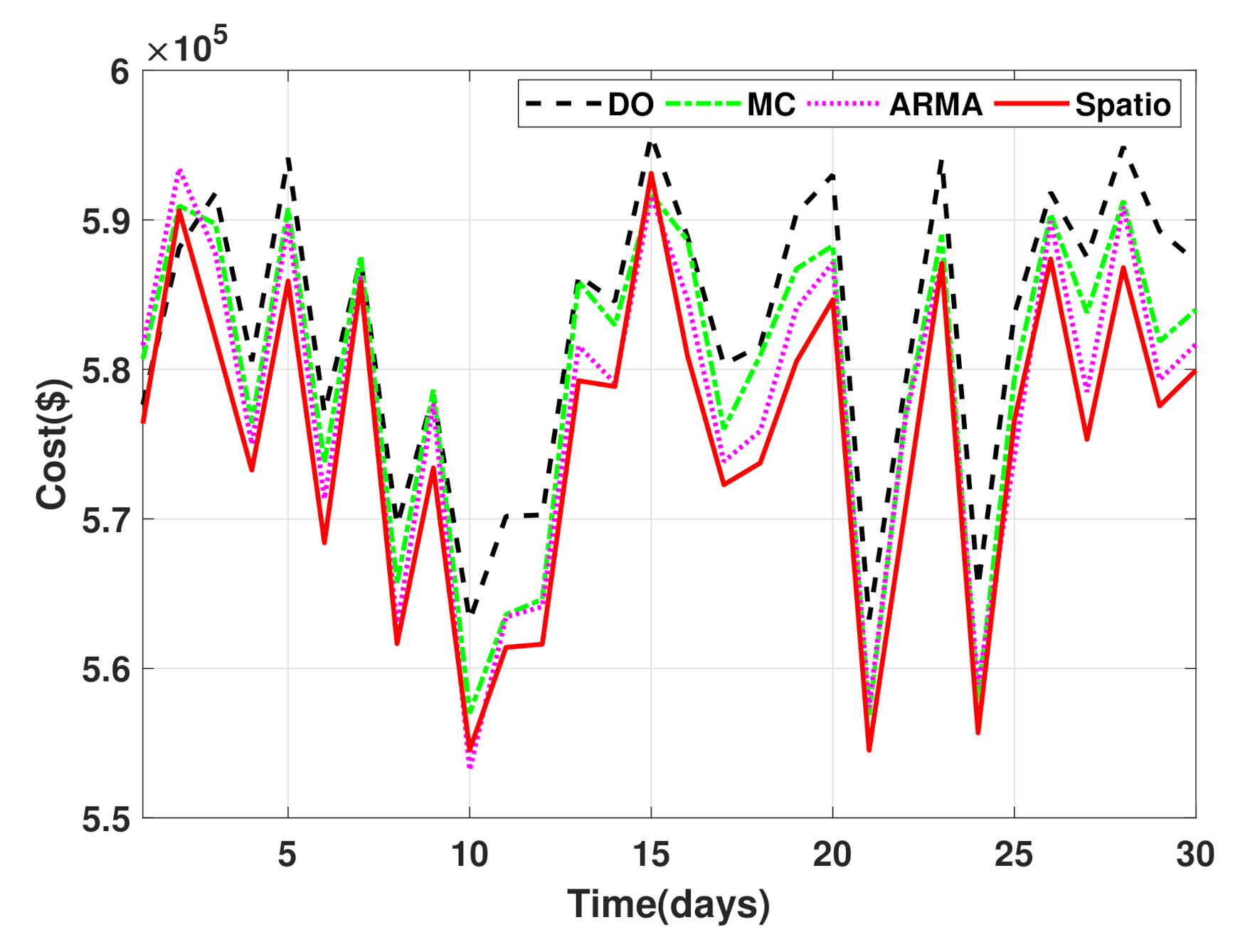Spatio-Temporal Kriging Based Economic Dispatch Problem Including Wind Uncertainty
Abstract
1. Introduction
1.1. Current Research
1.2. About the Present Paper
- (a)
- The development of a wind speed forecasting algorithm for renewable energy systems based on the spatio-temporal kriging and analog methods. The algorithm uses a database of wind speed and position measurements of locations near the forecast point to generate a prediction. The spatio-temporal model is used in order to capture any nonlinearities that are not covered by the temporal models.
- (b)
- The generation of sets of scenarios for wind generation from a spatio-temporal prediction model. In this way, the approach described here differs from the other research mentioned in the literature, where spatio-temporal models are only used to make punctual predictions. Both temporal and spatio-temporal methods for generating scenarios are compared.
- (c)
- Demonstration of the feasibility and practicality of the proposed model for integration into the economic dispatch framework. A stochastic economic dispatch model is proposed in which operational costs are minimized over the set of scenarios generated.
2. Mathematical Model for Wind Forecasting and Economic Dispatch
2.1. Overview of Scenario Generation Based Methods
2.2. Spatio-Temporal Based Method
2.2.1. Spatial Kriging
2.2.2. Spatio-Temporal Kriging
2.3. Stochastic Dispatch Problem Formulation
- Active power balance constraints: The balancing actions must ensure a balance between generation and demand in any possible scenario s. The constraint to be satisfied can be given as:where , , , , , and N are the wind power scenario s of generator w at t, the voltage angle of node n under s at t, the voltage angle of node m under s at t, the reactance of the line , the set of nodes directly connected to node n, and the set of nodes, respectively. We define bus 1 as the reference node by setting to zero.
- Transmission capacity constraints: For physical reasons, the amount of power transmitted through a power line has a limit. This limit is justified by thermal or stability considerations. Therefore, a line must be operated so that this transport limit is not exceeded under any circumstances. This is formulated as:where is the transmission capacity of the transmission line .
- Generation output constraints: Each unit is designed to work between the minimum power capacity and the maximum power capacity. The following constraint ensures that the unit is within its respective rated minimum and maximum capacity.where and are the minimum output of generator g and the maximum output of generator g.
- Wind curtailment constraint: The amount of wind power production that is curtailed under each scenario s must be lower than or equal to :
- Load shedding constraint: The amount of load that is shed in each scenario s has to be lower than or equal to the demand value:where is the maximum allowable load shedding percentage.
- Reserve constraints: The reserve capacity for the balancing energy is shown below:where and are the upward reserve capacity and downward reserve capacity, respectively.
- The quantity of reserves, generation, and demand must be non-negative:where is the set of decision variables .
3. Proposed Methodology
3.1. Empirical Variogram Calculation and Parametric Fitting
- (a)
- The separable covariance model assumes that the spatio-temporal covariance function is represented as the product of a spatial and temporal term:
- (b)
- The product-sum covariance model:with
- (c)
- The spatio-temporal metric covariance model:
- (d)
- The sum-metric covariance model:
- (e)
- The exponential covariance model:
3.2. Estimating the Weights and Derivation of the Kriging Estimator
3.3. Scenario Generation
4. Results and Discussion
4.1. Database Description
4.2. Results of Scenario Generation and Reduction
4.3. ED Results
4.4. Case 1: IEEE-3 Bus Test System
4.5. Case 2: IEEE-24 Bus Test System
5. Conclusions
- The proposed approach for spatio-temporal modeling has a better fit for the database than the ARMA and Monte Carlo methods. Therefore, it can be applied to predict the values on unobserved points from data measured around the unmeasured point. In this work, the data of the wind speed and the location of these measurements are used. It can also be mentioned that when the scenarios are generated, the Monte Carlo method is the one with the lowest computational cost. At the same time, the spatio-temporal approach has the highest cost.
- Because the weights of the kriging estimator depend on the modeled semivariogram, kriging is very sensitive to the misspecification of the semivariogram model.
- In general, interpolation accuracy by kriging is limited if the number of observations sampled is small. The data are limited in spatial scope, or the data are not broadly spatially correlated. In these cases, it is challenging to generate an experimental semivariogram.
- The number of scenarios is an important parameter and can have a significant impact on the cost function of the ED problem. A good value for is likely to depend on the method of scenario creation. For the presented approach, the stabilization of the objective function occurred in values close to 120 scenarios, as can be seen in Figure 7.
- An economic dispatch model that considers wind generation in its formulation is presented in this research. Wind generation is created using a kriging based spatio-temporal model and other methods commonly used for this purpose. The proposed approach’s effectiveness is demonstrated by the simulation of the modified IEEE 3-bus and IEEE-24 bus systems.
- The results show that spatio-temporal and analog models for generating scenarios can be integrated efficiently in the ED problem framework and reduce costs. The reduction in operating costs when using spatio-temporal scenarios is 1.230%.
Author Contributions
Funding
Acknowledgments
Conflicts of Interest
References
- Jiang, C.; Chen, Y.; Mao, Y.; Chai, Y.; Yu, M. Forecasting Spatio-Temporal Renewable Scenarios: A Deep Generative Approach. arXiv 2019, arXiv:1903.05274. [Google Scholar]
- Le, D.D.; Gross, G.; Berizzi, A. Probabilistic modeling of multisite wind farm production for scenario based applications. IEEE Trans. Sustain. Energy 2015, 6, 748–758. [Google Scholar] [CrossRef]
- Xie, L.; Gu, Y.; Zhu, X.; Genton, M.G. Short-Term Spatio-Temporal Wind Power Forecast in Robust Look-ahead Power System Dispatch. IEEE Trans. Smart Grid 2014, 5, 511–520. [Google Scholar] [CrossRef]
- Meibom, P.; Barth, R.; Hasche, B.; Brand, H.; Weber, C.; O’Malley, M. Stochastic optimization model to study the operational impacts of high wind penetrations in Ireland. IEEE Trans. Power Syst. 2011, 26, 1367–1379. [Google Scholar] [CrossRef]
- Yıldız, C.; Tekin, M.; Gani, A.; Keçecioğlu, Ö.; Açıkgöz, H.; Şekkeli, M. A Day-Ahead Wind Power Scenario Generation, Reduction, and Quality Test Tool. Sustainability 2017, 9, 864. [Google Scholar] [CrossRef]
- Camal, S.; Teng, F.; Michiorri, A.; Kariniotakis, G.; Badesa, L. Scenario generation of aggregated Wind, Photovoltaics and small Hydro production for power systems applications. Appl. Energy 2019, 242, 1396–1406. [Google Scholar] [CrossRef]
- Du, E.; Zhang, N.; Kang, C.; Xia, Q. Scenario Map Based Stochastic Unit Commitment. IEEE Trans. Power Syst. 2018, 33, 4694–4705. [Google Scholar] [CrossRef]
- Ming, H.; Xie, L.; Campi, M.C.; Garatti, S.; Kumar, P.R. Scenario-Based Economic Dispatch With Uncertain Demand Response. IEEE Trans. Smart Grid 2019, 10, 1858–1868. [Google Scholar] [CrossRef]
- Modarresi, M.S.; Xie, L.; Campi, M.C.; Garatti, S.; Care, A.; Thatte, A.A.; Kumar, P.R. Scenario-Based Economic Dispatch With Tunable Risk Levels in High-Renewable Power Systems. IEEE Trans. Power Syst. 2019, 34, 5103–5114. [Google Scholar] [CrossRef]
- Xu, J.; Wang, B.; Sun, Y.; Xu, Q.; Liu, J.; Cao, H.; Jiang, H.; Lei, R.; Shen, M. A day-ahead economic dispatch method considering extreme scenarios based on a wind power uncertainty set. CSEE J. Power Energy Syst. 2019. [Google Scholar] [CrossRef]
- Sandelic, M.; Stroe, D.I.; Iov, F. Battery Storage-Based Frequency Containment Reserves in Large Wind Penetrated Scenarios: A Practical Approach to Sizing. Energies 2018, 11, 3065. [Google Scholar] [CrossRef]
- Valizadeh Haghi, H.; Bina, M.T.; Golkar, M.A. Nonlinear modeling of temporal wind power variations. IEEE Trans. Sustain. Energy 2013, 4, 838–848. [Google Scholar] [CrossRef]
- Salehi Borujeni, M.; Akbari Foroud, A.; Dideban, A. Wind speed scenario generation based on dependency structure analysis. J. Wind Eng. Ind. Aerodyn. 2018, 172, 453–465. [Google Scholar] [CrossRef]
- Ezzat, A.A.; Jun, M.; Ding, Y. Spatio-temporal asymmetry of local wind fields and its impact on short-term wind forecasting. IEEE Trans. Sustain. Energy 2018, 9, 1437–1447. [Google Scholar] [CrossRef] [PubMed]
- Xie, L.; Gu, Y.; Zhu, X.; Genton, M.G. Power system economic dispatch with spatio-temporal wind forecasts. In Proceedings of the IEEE 2011 EnergyTech, Cleveland, OH, USA, 25–26 May 2011; pp. 1–6. [Google Scholar] [CrossRef]
- Xie, L.; Gu, Y.; Zhu, X.; Genton, M. Short-term spatio-temporal wind power forecast in robust look-ahead power system dispatch. In Proceedings of the 2016 IEEE Power and Energy Society General Meeting (PESGM), Boston, MA, USA, 17–21 July 2016; p. 1. [Google Scholar] [CrossRef]
- Tascikaraoglu, A.; Sanandaji, B.M.; Chicco, G.; Cocina, V.; Spertino, F.; Erdinc, O.; Paterakis, N.G.; Catalao, J.P.S. A short-term spatio-temporal approach for Photovoltaic power forecasting. In Proceedings of the 2016 Power Systems Computation Conference (PSCC), Genoa, Italy, 20–24 June 2016; pp. 1–7. [Google Scholar] [CrossRef]
- Zhao, Y.; Ye, L.; Wang, Z.; Wu, L.; Zhai, B.; Lan, H.; Yang, S. Spatio-temporal Markov chain model for very-short-term wind power forecasting. J. Eng. 2019, 2019, 5018–5022. [Google Scholar] [CrossRef]
- Sun, M.; Feng, C.; Zhang, J. Conditional aggregated probabilistic wind power forecasting based on spatio-temporal correlation. Appl. Energy 2019, 256, 113842. [Google Scholar] [CrossRef]
- Suryawanshi, A.; Ghosh, D. Wind speed prediction using spatio-temporal covariance. Nat. Hazards 2015, 75, 1435–1449. [Google Scholar] [CrossRef]
- Agoua, X.G.; Girard, R.; Kariniotakis, G. Probabilistic Models for Spatio-Temporal Photovoltaic Power Forecasting. IEEE Trans. Sustain. Energy 2019, 10, 780–789. [Google Scholar] [CrossRef]
- Zhu, Q.; Chen, J.; Zhu, L.; Duan, X.; Liu, Y. Wind Speed Prediction with Spatio–Temporal Correlation: A Deep Learning Approach. Energies 2018, 11, 705. [Google Scholar] [CrossRef]
- Hama, K.; Fujimoto, Y.; Hayashi, Y. Expected Wind Speed Estimation Considering Spatio-Temporal Anisotropy for Generating Synthetic Wind Power Profiles. Energy Procedia 2018, 155, 309–319. [Google Scholar] [CrossRef]
- Dowell, J.; Weiss, S.; Hill, D.; Infield, D. Short-term spatio-temporal prediction of wind speed and direction. Wind Energy 2014, 17, 1945–1955. [Google Scholar] [CrossRef]
- Dowell, J.; Weiss, S.; Infield, D. Kernel methods for short-term spatio-temporal wind prediction. In Proceedings of the 2015 IEEE Power & Energy Society General Meeting, Denver, CO, USA, 26–30 July 2015; Volume 2015, pp. 1–5. [Google Scholar] [CrossRef]
- Khodayar, M.; Wang, J. Spatio-Temporal Graph Deep Neural Network for Short-Term Wind Speed Forecasting. IEEE Trans. Sustain. Energy 2019, 10, 670–681. [Google Scholar] [CrossRef]
- Agoua, X.G.; Girard, R.; Kariniotakis, G. Short-Term Spatio-Temporal Forecasting of Photovoltaic Power Production. IEEE Trans. Sustain. Energy 2018, 9, 538–546. [Google Scholar] [CrossRef]
- Aryaputera, A.W.; Yang, D.; Zhao, L.; Walsh, W.M. Very short-term irradiance forecasting at unobserved locations using spatio-temporal kriging. Sol. Energy 2015, 122, 1266–1278. [Google Scholar] [CrossRef]
- Jamaly, M.; Kleissl, J. Spatiotemporal interpolation and forecast of irradiance data using Kriging. Sol. Energy 2017, 158, 407–423. [Google Scholar] [CrossRef]
- Hu, Q.; Chen, H.; Tao, Y.; Yang, R.; Wang, L.; Hu, P. Wind speed spatio-temporal forecasting of wind farms based on universal kriging and Bayesian dynamic model. In Proceedings of the 2014 International Conference on Power System Technology, Chengdu, China, 20–22 October 2014; pp. 2897–2902. [Google Scholar] [CrossRef]
- He, M.; Yang, L.; Zhang, J.; Vittal, V. Spatio-temporal analysis for smart grids with wind generation integration. In Proceedings of the 2013 International Conference on Computing, Networking and Communications (ICNC), San Diego, CA, USA, 28–31 January 2013; pp. 1107–1111. [Google Scholar] [CrossRef]
- Lenzi, A.; Steinsland, I.; Pinson, P. Spatio-temporal modeling for short term wind power forecasts. Why, when and how. In Proceedings of the EGU General Assembly Conference Abstracts, Vienna, Austria, 23–28 April 2017; p. 3633. [Google Scholar]
- Filik, T. Improved Spatio-Temporal Linear Models for Very Short-Term Wind Speed Forecasting. Energies 2016, 9, 168. [Google Scholar] [CrossRef]
- Lorca, A.; Sun, X.A. Adaptive Robust Optimization With Dynamic Uncertainty Sets for Multi-Period Economic Dispatch Under Significant Wind. IEEE Trans. Power Syst. 2015, 30, 1702–1713. [Google Scholar] [CrossRef]
- Bessa, R.J.; Trindade, A.; Miranda, V. Spatial-temporal solar power forecasting for smart grids. IEEE Trans. Ind. Inform. 2015, 11, 232–241. [Google Scholar] [CrossRef]
- He, X.D.; Cui, C.G.; Yang, N. The Kriging model based scenario generation and its application in the energy internet with high wind penetration. In Proceedings of the 2017 IEEE Conference on Energy Internet and Energy System Integration (EI2), Beijing, China, 26–28 November 2017; pp. 1–6. [Google Scholar] [CrossRef]
- Tascikaraoglu, A.; Sanandaji, B.M. Short-term residential electric load forecasting: A compressive spatio-temporal approach. Energy Build. 2016, 111, 380–392. [Google Scholar] [CrossRef]
- Zhu, X.; Genton, M.G.; Gu, Y.; Xie, L. Space-time wind speed forecasting for improved power system dispatch. Test 2014, 23, 1–25. [Google Scholar] [CrossRef]
- Fan, F.; Bell, K.; Hill, D.; Infield, D. Wind forecasting using kriging and vector auto-regressive models for dynamic line rating studies. In Proceedings of the 2015 IEEE Eindhoven PowerTech, Eindhoven, The Netherlands, 29 June–2 July 2015; pp. 1–6. [Google Scholar] [CrossRef]
- Tang, J.; Wang, D.; Wang, X.; Jia, H.; Wang, C.; Huang, R.; Yang, Z.; Fan, M. Study on day-ahead optimal economic operation of active distribution networks based on Kriging model assisted particle swarm optimization with constraint handling techniques. Appl. Energy 2017, 204, 143–162. [Google Scholar] [CrossRef]
- van Stein, B.; Wang, H.; Kowalczyk, W.; Emmerich, M.; Bäck, T. Cluster based Kriging approximation algorithms for complexity reduction. Appl. Intell. 2020, 50, 778–791. [Google Scholar] [CrossRef]
- Strandberg, J.; Sjöstedt de Luna, S.; Mateu, J. Prediction of spatial functional random processes: Comparing functional and spatio-temporal kriging approaches. Stoch. Environ. Res. Risk Assess. 2019, 33, 1699–1719. [Google Scholar] [CrossRef]
- Analui, B.; Scaglione, A. An approximation algorithm for future wind scenarios. In Proceedings of the 2016 IEEE Statistical Signal Processing Workshop (SSP), Palma de Mallorca, Spain, 26–29 June 2016; pp. 1–5. [Google Scholar] [CrossRef]
- Pishgar-Komleh, S.; Keyhani, A.; Sefeedpari, P. Wind speed and power density analysis based on Weibull and Rayleigh distributions (a case study: Firouzkooh county of Iran). Renew. Sustain. Energy Rev. 2015, 42, 313–322. [Google Scholar] [CrossRef]
- Sharma, K.C.; Jain, P.; Bhakar, R. Wind Power Scenario Generation and Reduction in Stochastic Programming Framework. Electr. Power Components Syst. 2013, 41, 271–285. [Google Scholar] [CrossRef]
- Chen, J.; Rabiti, C. Synthetic wind speed scenarios generation for probabilistic analysis of hybrid energy systems. Energy 2017, 120, 507–517. [Google Scholar] [CrossRef]
- Ding, Y. Data Science for Wind Energy; Chapman and Hall, CRC: Boca Raton, FL, USA, 2019. [Google Scholar] [CrossRef]
- Varouchakis, E.A.; Hristopulosb, D.T. Comparison of spatiotemporal variogram functions based on a sparse dataset of groundwater level variations. Spat. Stat. 2019, 34, 100245. [Google Scholar] [CrossRef]
- Xu, J.; Shu, H. Spatio-temporal kriging based on the product-sum model: Some computational aspects. Earth Sci. Inform. 2015, 8, 639–648. [Google Scholar] [CrossRef]
- Li, W.; Duan, Q.; Miao, C.; Ye, A.; Gong, W.; Di, Z. A review on statistical postprocessing methods for hydrometeorological ensemble forecasting. Wiley Interdiscip. Rev. Water 2017, 4, e1246. [Google Scholar] [CrossRef]
- Ben Daoud, A.; Sauquet, E.; Bontron, G.; Obled, C.; Lang, M. Daily quantitative precipitation forecasts based on the analogue method: Improvements and application to a French large river basin. Atmos. Res. 2016, 169, 147–159. [Google Scholar] [CrossRef]
- Morales, J.M.; Zugno, M.; Pineda, S.; Pinson, P. Electricity market clearing with improved scheduling of stochastic production. Eur. J. Oper. Res. 2014, 235, 765–774. [Google Scholar] [CrossRef]
- Carrillo, C.; Obando Montaño, A.F.; Cidrás, J.; Díaz-Dorado, E. Review of power curve modelling for wind turbines. Renew. Sustain. Energy Rev. 2013, 21, 572–581. [Google Scholar] [CrossRef]
- Gazafroudi, A.S.; Shafie-khah, M.; Prieto-Castrillo, F.; Talari, S.; Corchado, J.M.; Catalão, J.P. Evolving New Market Structures. Pathways Smarter Power Syst. 2019, 183–203. [Google Scholar] [CrossRef]
- Ordoudis, C.; Pinson, P.; González, J.M.M.; Zugno, M. An Updated Version of the IEEE RTS 24-Bus System for Electricity Market and Power System Operation Studies; Technical University of Denmark: Kgs. Lyngby, Denmark, 2016; pp. 1–6. [Google Scholar]










| Ref. | Subject | STV | PFCST | Scen. | TF | Model | ||||
|---|---|---|---|---|---|---|---|---|---|---|
| FCST | PLNG | UC/ED | Wind | Solar | Demand | |||||
| [15,16] | ✓ | ✓ | ✓ | short | Trigonometric direction diurnal model | |||||
| [17] | ✓ | ✓ | short | Compressive spatio-temporal forecasting | ||||||
| [18] | ✓ | ✓ | ✓ | short | Spatio-temporal Markov chain | |||||
| [19] | ✓ | ✓ | ✓ | short | Copula function | |||||
| [20] | ✓ | ✓ | ✓ | short/long | Spatio-temporal covariance model | |||||
| [21] | ✓ | ✓ | ✓ | short | QR-Lasso spatial-temporal | |||||
| [22] | ✓ | ✓ | ✓ | short | Predictive deep convolutional neural network | |||||
| [23] | ✓ | ✓ | ✓ | short | Spatio-temporal kriging | |||||
| [24] | ✓ | ✓ | ✓ | short | Low-cost spatio-temporal adaptive filter | |||||
| [25] | ✓ | ✓ | ✓ | short | Kernel methods | |||||
| [26] | ✓ | ✓ | ✓ | short | Graph based convolution network | |||||
| [27] | ✓ | ✓ | ✓ | short | Spatio-temporal model using clusters of meteorological conditions | |||||
| [28,29] | ✓ | ✓ | ✓ | ✓ | short | Spatio-temporal kriging | ||||
| [30] | ✓ | ✓ | ✓ | short | Universal kriging and a Bayesian dynamic model | |||||
| [31] | ✓ | ✓ | ✓ | short | Finite state Markov chain model | |||||
| [32] | ✓ | ✓ | ✓ | short | Bayesian spatio-temporal model | |||||
| [33] | ✓ | ✓ | ✓ | short | Multi-channel ARMA model | |||||
| [2] | ✓ | ✓ | ✓ | short | Principal component analysis-time series | |||||
| [34] | ✓ | ✓ | ✓ | short | Dynamic uncertainty sets | |||||
| [35] | ✓ | ✓ | ✓ | short | Vector autoregressive (VAR) framework | |||||
| [36] | ✓ | ✓ | ✓ | short | Kriging model and importance sampling method | |||||
| [37] | ✓ | ✓ | ✓ | short | Compressive sensing and structured-sparse recovery algorithms | |||||
| [38] | ✓ | ✓ | ✓ | short | A modified regime-switching space-time diurnal (RSTD) model | |||||
| Proposed | ✓ | ✓ | ✓ | short | Spatio-temporal kriging and analog models | |||||
| Method | Mean | MAE | RMSE |
|---|---|---|---|
| ARMA model | 7.613 | 0.314 | 1.079 |
| Monte Carlo | 7.599 | 0.312 | 1.103 |
| Spatio-temporal | 7.164 | 0.284 | 0.934 |
| Method | Initial Costs ($) | Ex-Post Costs ($) |
|---|---|---|
| DO | 47,265.129 | 50,984.885 |
| ARMA model | 48,891.282 | 40,502.540 |
| Monte Carlo | 47,684.425 | 42,168.046 |
| Spatio-temporal | 47,735.511 | 39,971.381 |
| Demand (MW) | 177.500 | 166.900 | 159.030 | 156.300 | 156.300 | 159.030 | 196.100 | 227.900 | 251.700 | 251.700 |
| Variable\Time | ||||||||||
|---|---|---|---|---|---|---|---|---|---|---|
| (MW) | 78.625 | 68.555 | 60.777 | 58.122 | 58.040 | 61.079 | 96.295 | 126.505 | 150.000 | 150.000 |
| (MW) | 10.000 | 10.000 | 10.000 | 10.00 | 10.000 | 10.000 | 10.000 | 10.000 | 10.604 | 10.937 |
| (MW) | 80.000 | 80.00 | 80.000 | 80.000 | 80.000 | 80.000 | 80.00 | 80.000 | 80.000 | 80.000 |
| Wind (MW) | 8.875 | 8.345 | 8.253 | 8.178 | 8.259 | 7.952 | 9.805 | 11.395 | 11.096 | 10.763 |
| Variable\Time | ||||||||||
|---|---|---|---|---|---|---|---|---|---|---|
| (MW) | 78.625 | 68.555 | 61.079 | 58.485 | 58.485 | 61.079 | 96.295 | 126.505 | 149.115 | 149.115 |
| (MW) | 10.000 | 10.000 | 10.000 | 10.000 | 10.000 | 10.000 | 10.000 | 10.000 | 10.000 | 10.000 |
| (MW) | 80.000 | 80.000 | 80.000 | 80.000 | 80.000 | 80.000 | 80.000 | 80.000 | 80.000 | 80.000 |
| Wind (MW) | 8.875 | 8.345 | 7.952 | 7.815 | 7.815 | 7.952 | 9.805 | 11.395 | 12.585 | 12.585 |
| Variable\Time | ||||||||||
|---|---|---|---|---|---|---|---|---|---|---|
| (MW) | 78.625 | 71.661 | 61.079 | 58.654 | 58.485 | 63.801 | 99.035 | 133.912 | 150.000 | 150.000 |
| (MW) | 10.00 0 | 10.000 | 10.000 | 10.000 | 10.000 | 10.000 | 10.000 | 10.000 | 10.874 | 13.714 |
| (MW) | 80.000 | 80.000 | 80.000 | 80.000 | 80.000 | 80.000 | 80.000 | 80.000 | 80.000 | 80.000 |
| Wind (MW) | 8.875 | 5.239 | 7.952 | 7.646 | 7.815 | 5.229 | 7.065 | 3.988 | 10.826 | 7.987 |
| Method | Time (s) |
|---|---|
| DO | 18.975 |
| ARMA model | 30.688 |
| Monte Carlo | 31.720 |
| Spatio-temporal | 33.221 |
| Method | Initial Costs ($) | Ex-Post Costs ($) |
|---|---|---|
| DO | 324,281.956 | 580,689.927 |
| ARMA model | 617,789.669 | 577,629.647 |
| Monte Carlo | 635,792.068 | 581,598.627 |
| Spatio-temporal | 594,790.979 | 576,376.125 |
| Method | Time (s) |
|---|---|
| DO | 23.229 |
| ARMA model | 448.288 |
| Monte Carlo | 410.833 |
| Spatio-temporal | 429.401 |
| DO | Monte Carlo | ARMA | Spatio-Temporal | |
|---|---|---|---|---|
| Average ($) | 582,840.000 | 579,740.000 | 577,970.000 | 575,670.000 |
| % | - | 0.532 | 0.836 | 1.230 |
Publisher’s Note: MDPI stays neutral with regard to jurisdictional claims in published maps and institutional affiliations. |
© 2020 by the authors. Licensee MDPI, Basel, Switzerland. This article is an open access article distributed under the terms and conditions of the Creative Commons Attribution (CC BY) license (http://creativecommons.org/licenses/by/4.0/).
Share and Cite
Tinitana, J.C.C.; Correa-Florez, C.A.; Patino, D.; Vuelvas, J. Spatio-Temporal Kriging Based Economic Dispatch Problem Including Wind Uncertainty. Energies 2020, 13, 6419. https://doi.org/10.3390/en13236419
Tinitana JCC, Correa-Florez CA, Patino D, Vuelvas J. Spatio-Temporal Kriging Based Economic Dispatch Problem Including Wind Uncertainty. Energies. 2020; 13(23):6419. https://doi.org/10.3390/en13236419
Chicago/Turabian StyleTinitana, Julio César Cuenca, Carlos Adrian Correa-Florez, Diego Patino, and José Vuelvas. 2020. "Spatio-Temporal Kriging Based Economic Dispatch Problem Including Wind Uncertainty" Energies 13, no. 23: 6419. https://doi.org/10.3390/en13236419
APA StyleTinitana, J. C. C., Correa-Florez, C. A., Patino, D., & Vuelvas, J. (2020). Spatio-Temporal Kriging Based Economic Dispatch Problem Including Wind Uncertainty. Energies, 13(23), 6419. https://doi.org/10.3390/en13236419








